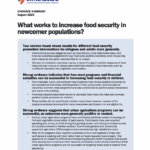There are 26 million refugees globally, with as many as 80% facing food insecurity irrespective of location. Food insecurity results in malnutrition beginning at an early age and disproportionately affects certain groups such as women. Food security is a complex issue and must consider gender, policies, social and cultural contexts that refugees face. Our aim is to assess what is known about food security interventions in refugees and identify existing gaps in knowledge. This scoping review followed the guidelines set out in the PRISMA Extension for Scoping Reviews. We included all articles that discussed food security interventions in refugees published between 2010 and 2020. A total of 57 articles were eligible for this study with most interventions providing cash, vouchers, or food transfers; urban agriculture, gardening, animal husbandry, or foraging; nutrition education; and infant and young child feeding. Urban agriculture and nutrition education were more prevalent in destination countries. While urban agriculture was a focus of the FAO and cash/voucher interventions were implemented by the WFP, the level of collaboration between UN agencies was unclear. Food security was directly measured in 39% of studies, half of which used the UN’s Food Consumption Score, and the remainder using a variety of methods. As substantiated in the literature, gender considerations are vital to the success of food security interventions, and although studies include this in the planning process, few see gender considerations through to implementation. Including host communities in food security interventions improves the refugee–host relationship. Collaboration should be encouraged among aid organizations. To assess intervention efficacy, food security should be measured with a consistent tool. With the number of refugees in the world continuing to rise, further efforts are required to transition from acute aid to sustainability through livelihood strategies.
A Systematic Review on the Impact of Trauma-Informed Education Programs on Academic and Academic-Related Functioning for Students Who Have Experienced Childhood Adversity
The purpose of this study was to conduct a systematic review of the existing literature regarding trauma-informed education programs and their impact on academic and academic-related outcomes. The articles included for review (n=15) contained data on trauma-informed education programs implemented in preschool, primary/elementary, and high school settings. Academic and academic-related outcomes reported included attendance, disciplinary…

